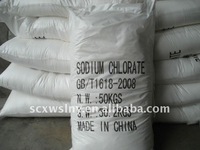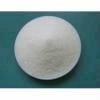- Explosive[7]
- Chlorate[10]
- Other Inorganic Salts[3]
- Contact Person : Mr. Wang Alex
- Company Name : Sichuan Hope Deepblue Energy & Chemical Industry Corp., Ltd.
- Tel : 86-28-85960318
- Fax : 86-28-85965538
- Address : Sichuan,Chengdu,No. 181, Jichang Road
- Country/Region : China
- Zip : 610225
Bleaching Chlorate Powder
MSDS Name: Sodium Chlorate
Molecular Formula: NaClO3
Company Identification: Sichuan Hope Deepblue Energy & Chemical Corp., Ltd.
Place of Origin: Sichuan, China
Brand Name: Hope Deepblue
EINECS No.: 231-887-4
Section 2 - COMPOSITION, INFORMATION ON INGREDIENTS
|
CAS No.: 7775-09-9
Chemical Name: Sodium Chlorate
Content: 99.3%-99.6%
Section 3 - HAZARDS IDENTIFICATIONEMERGENCY OVERVIEWHarmful if swallowed. Explosive when mixed with combustible material.Potential Health EffectsEye:Causes eye irritation. May cause conjunctivitis. May cause permanent corneal opacification.Skin:Causes skin irritation. May cause severe irritation and possible burns.Ingestion:Causes gastrointestinal irritation with nausea, vomiting and diarrhea. May be harmful if swallowed. May cause burns to the gastrointestinal tract. May cause systemic effects by ingestion: blood hemolysis with or without anemia, methemoglobinemia-carboxyhemoglobinemia, and pulmonary changes. May cause damage to the red blood cells. May cause nausea, vomiting, and diarrhea, possibly with blood.Inhalation:Causes respiratory tract irritation. May cause acute pulmonary edema, asphyxia, chemical pneumonitis, and upper airway obstruction caused by edema.Chronic:May cause methemoglobinemia, which is characterized by chocolate-brown colored blood, headache, weakness, dizziness, breath shortness, cyanosis (bluish skin due to deficient oxygenation of blood), rapid heart rate, unconsciousness and possible death.Laboratory experiments have resulted in mutagenic effects. May cause kidney damage.
Section 4 - FIRST AID MEASURESEyes:Immediately flush eyes with plenty of water for at least 15 minutes, occasionally lifting the upper and lower eyelids. Get medical aid immediately.Skin:Get medical aid. Flush skin with plenty of water for at least 15 minutes while removing contaminated clothing and shoes. Wash clothing before reuse.Ingestion:Do not induce vomiting. If victim is conscious and alert, give 2-4 cupfuls of milk or water. Never give anything by mouth to an unconscious person. Get medical aid immediately.Inhalation:Remove from exposure and move to fresh air immediately. If not breathing, give artificial respiration. If breathing is difficult, give oxygen. Get medical aid.Notes to Physician:For methemoglobinemia, administer oxygen alone or with Methylene Blue depending on the methemoglobin concentration in the blood.Antidote: Do not use oils, greases or protective cream on skin. Do NOT use oils or ointments in eye.
Section 5 - FIRE FIGHTING MEASURESGeneral Information:As in any fire, wear a self-contained breathing apparatus in pressure-demand, MSHA/NIOSH (approved or equivalent), and full protective gear. Strong oxidizer. Contact with other material may cause fire. Use water with caution and in flooding amounts. May accelerate burning if involved in a fire.Extinguishing Media:Contact professional fire-fighters immediately. Cool containers with flooding quantities of water until well after fire is out. Use water fog only.
Section 6 - ACCIDENTAL RELEASE MEASURESGeneral Information: Use proper personal protective equipment as indicated in Section 8.Spills/Leaks:Vacuum or sweep up material and place into a suitable disposal container. Clean up spills immediately, observing precautions in the Protective Equipment section. Avoid generating dusty conditions.Remove all sources of ignition. Do not use combustible materials such as paper towels to clean up spill. Keep combustibles (wood, paper, oil, etc.,) away from spilled material.
Section 7 - HANDLING and STORAGEHandling:Wash thoroughly after handling. Use only in a well-ventilated area.Minimize dust generation and accumulation. Avoid contact with eyes, skin, and clothing. Keep container tightly closed. Avoid contact with clothing and other combustible materials. Avoid ingestion and inhalation.Storage:Keep away from heat, sparks, and flame. Keep away from sources of ignition. Do not store near combustible materials. Store in a tightly closed container. Store in a cool, dry, well-ventilated area away from incompatible substances. Keep away from reducing agents.
Section 8 - EXPOSURE CONTROLS, PERSONAL PROTECTIONEngineering Controls:Facilities storing or utilizing this material should be equipped with an eyewash facility and a safety shower. Use adequate ventilation to keep airborne concentrations low.Exposure Limits CAS# 7775-09-9: Russia: 5 mg/m3 TWA Personal Protective Equipment Eyes: Wear appropriate protective eyeglasses or chemical safety goggles as described by OSHA's eye and face protection regulations in 29 CFR 1910.133 or European Standard EN166.Skin:Wear appropriate protective gloves to prevent skin exposure.Clothing:Wear appropriate protective clothing to prevent skin exposure.Respirators:A respiratory protection program that meets OSHA's 29 CFR 1910.134 and ANSI Z88.2 requirements or European Standard EN 149 must be followed whenever workplace conditions warrant respirator use.
Section 9 - PHYSICAL AND CHEMICAL PROPERTIESPhysical State: CrystalsColor: whiteOdor: odorlesspH: 5.0-7.0Vapor Pressure: Not applicable.Viscosity: Not available.Boiling Point: DecomposesFreezing/Melting Point: 248 deg CAutoignition Temperature: Not applicable.Flash Point: Not applicable.Explosion Limits, lower: Not available.Explosion Limits, upper: Not available.Decomposition Temperature: Not available.Solubility in water: Soluble.Specific Gravity/Density: 2.4900
Professional sodium chlorate supplier in China!
UN Number 1495
Class: 5.1
Bleaching Chlorate Powder










